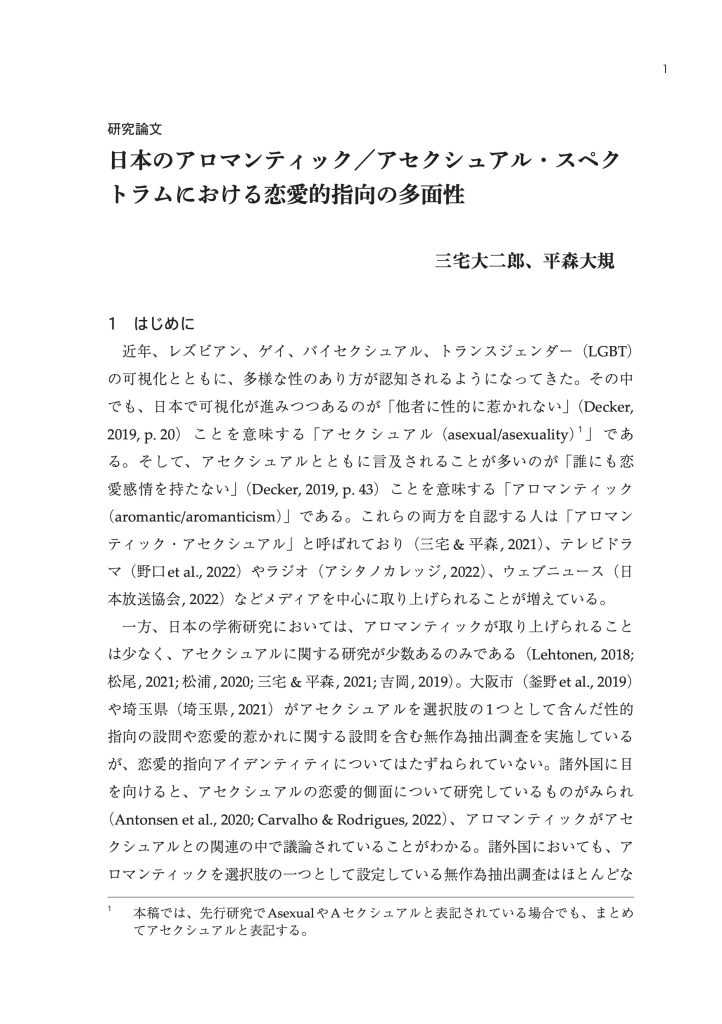I published a co-authored journal article “Multidimensionality of Romantic Orientation among the Aromantic/Asexual Spectrum in Japan” in the journal Gender and Sexuality. In recent years, the aromantic/asexual spectrum has become more visible in Japan, and research on asexuality is increasing but remains limited. However, there is even less research on aromanticism. This study sheds a light on the multidimensionality of romantic orientation, an understudied topic in Japan and abroad.
- Miyake, Daijiro, and Daiki Hiramori. 2023. “Multidimensionality of Romantic Orientation among the Aromantic/Asexual Spectrum in Japan.” Gender and Sexuality 18:1-25. In Japanese.
Abstract: In recent years, the aromantic/asexual spectrum has become more visible in Japan, and research on sexual orientation among the aromantic/asexual spectrum remains limited but is increasing. However, there is extremely little research that focuses on romantic orientation. Studies on romantic orientation in Western countries tend to discuss aromanticism as one of the romantic orientations that asexual people possess. In Japan, on the other hand, the framing of romantic orientation in the aromantic/asexual spectrum community differs from that in Western countries, as the terminology in Japan occasionally labels someone “asexual” only if they are neither romantically nor sexually attracted to other people. Furthermore, extant quantitative research tends to be limited to discussions that rely on the dichotomy of aromantic or not, despite findings from community-based surveys that suggest romantic orientation is multifaceted, making it necessary to discuss various dimensions of romantic orientation. This study used the “Aromantic/Asexual Spectrum Survey 2020,” a web survey conducted by the Aro/Ace Survey Executive Committee, to examine the multidimensionality of romantic orientation by describing romantic identity, romantic attraction, and romantic desire. Findings indicated that the distributions of romantic attraction before and after self-identification as aro-ace differed by aromantic spectrum identity, such as alloromantic, aromantic, gray(a)romantic, demiromantic, lithromantic, and questioning. Differences by aromantic spectrum identity were also observed in the distributions of deep interest in a particular person, romantic excitement, and the desire to date. Items related to desires that involve actions with others, such as the desire to date, tended to have a lower percentage of positive responses than items related to desires that do not necessarily involve actions with others, such as deep interest in a particular person and romantic excitement.
Keywords: aromantic, asexual, community-based survey, LGBT, romantic orientation
このたび、共著論文「日本のアロマンティック/アセクシュアル・スペクトラムにおける恋愛的指向の多面性」が『ジェンダー&セクシュアリティ』より出版されました。近年、日本においてアロマンティック/アセクシュアル・スペクトラムの可視化が進んでおり、アセクシュアルに関する研究も少数ではあるものの増えつつありますが、アロマンティックに関する研究はほとんどありません。本研究は国内外でも蓄積の少ない恋愛的指向の多面性を明らかにするものになっています。
- 三宅大二郎・平森大規,2023,「日本のアロマンティック/アセクシュアル・スペクトラムにおける恋愛的指向の多面性」『ジェンダー&セクシュアリティ』18: 1-25.

